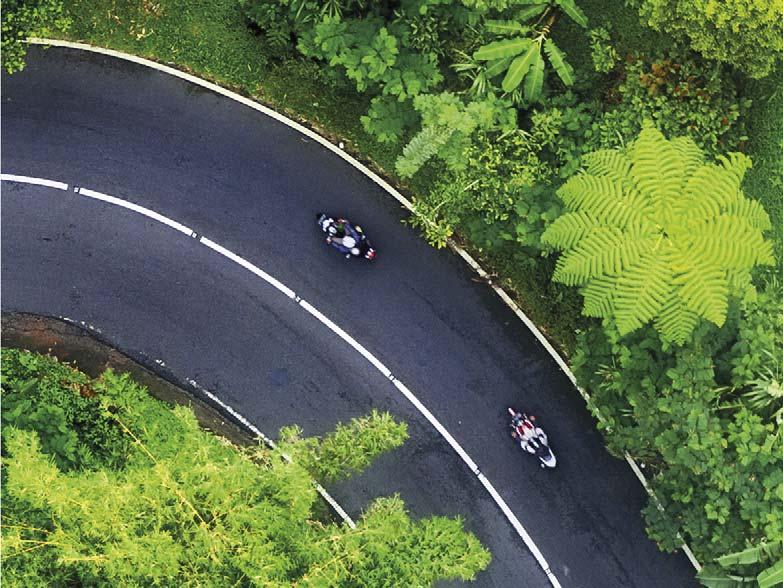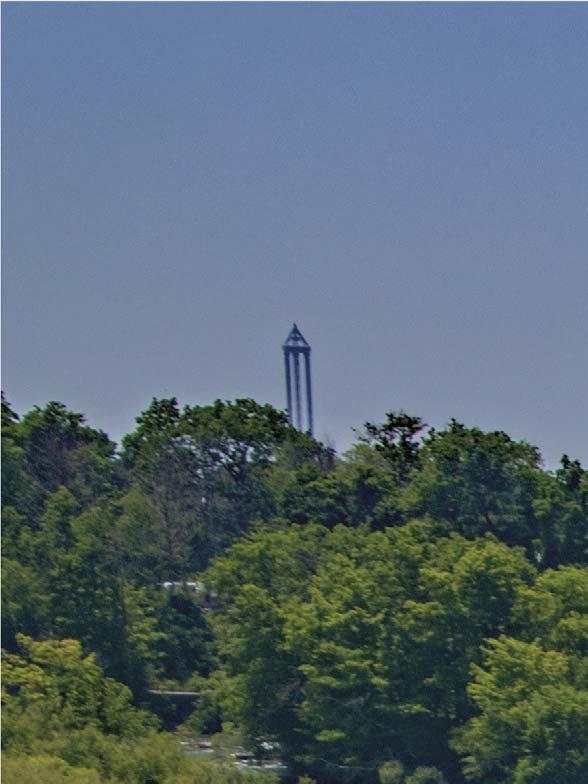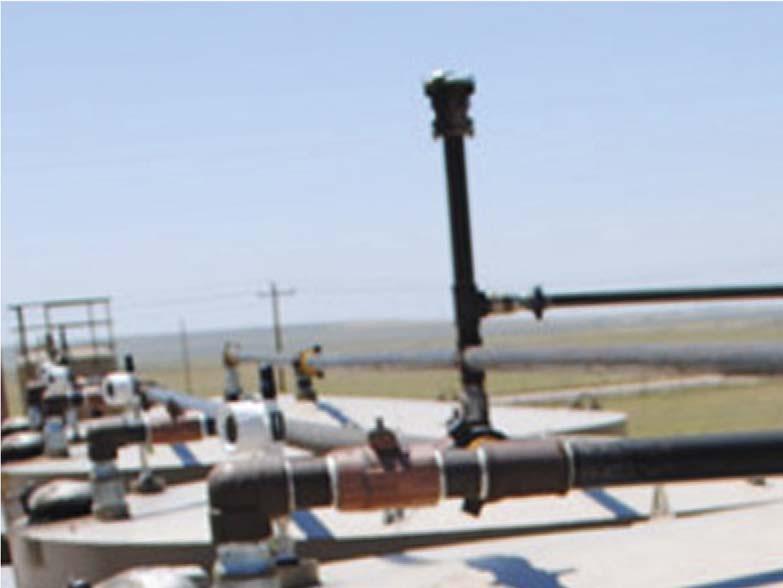
15 minute read
On the turn







Benoit Deschamps and Nicolas Sluys, Rubicon Oilfield International, explore a new rotational function of the drill string that combines technology developments with a well life cycle solutions approach.












The oil and gas industry trend moves the needle to ever more challenging wells in terms of measured depths, lateral departure or trajectory complexities, with the objective to maximise the reservoir exposition while minimising overburden costs.
Therefore, new methods must be introduced to: Ì Drive operational execution and production efficiency. Ì Improve well construction reliability to decrease further interventions, avoid production deferral or early plug and abandonment. Ì Better manage operational risks.
This needs to be achieved while also reducing both CAPEX and OPEX through the well life cycle.
Continuous improvements, targeting increased reliability and operational performance of current methods and technologies are a natural and mandatory focus of the technical teams involved in well planning and design, technology and operations. These are the ‘what else?’ or ‘what more?’ approaches, inherent to sustaining development.
There is also value in taking some steps back and revisiting the potential of commonly used or established practices and technologies. In this case, the thought process is primarily fuelled by a ‘what if?’ or a ‘why?’ approach.



The purpose
Fundamentally, the drilling, casing deployment, completions and intervention phases of the well life cycle will be achieved through the implementation of three basic mechanical functions provided by the drilling rig, surface and downhole equipment: the pulling, the pumping, and the rotational capabilities. These functions are supported by improved decision-making processes resulting from measurement, communication, interpretation and automation.

As a critical piece of the well construction phase, the drill string connects the surface equipment to the downhole target. As a continuous component, the drill string or casing string will do the following: Ì Ensure the transfer of downhole weight (such as weight on bit) by managing the surface hookload and the assessment of frictional losses along the string. Ì Drive the fluids circulation, the inherent requirement for pressure related operations. Ì Allow the transfer of the rotation initiated from surface down to downhole equipment. Inversely, torque, resulting from any tangential force applied along the string, will cumulate from the bottom up to surface. The rotational system needs to have enough torsional capability (power and mechanical ratings) to ensure continuous rotation to the string.
When designing the well, from a purely mechanical integrity perspective, the operator will ensure the surface equipment and the drill string components meet the necessary requirements in terms of maximum overpull and compression, torque and burst and collapse in the expected drilling environment (temperature, fluids type, fatigue, casing wear, formation pressure and frac gradient, etc.). The variety of the components (dimension [outer and internal diameters], materials and connections properties) can lead to substantial diff erences in terms of mechanical ratings along the string and need to be identified by the operator. Analytical methodologies, such as torque and drag analysis, will allow identifying the forces applied on the string and, from there, their cumulative eff ect in terms of
Ì Ì Ì Ì Ì Ì
Inadequate hole cleaning. An inability to deploy casing or completions to target depth. Damage to float, stage cementing or production equipment due to excessive or erratic load transfer. Differential sticking. Suboptimal cementing processes subjecting the wellbore to poor zonal isolation and wellbore integrity issues. An inability to implement efficient well intervention operations.
These challenges can either decrease the expected performance (suboptimal technical performance, increased operational time and expenditure) or potentially turn risks into showstoppers calling for contingency or alternative plans, at best. The capability to quickly and eff ectively react positively impacts the ability to mitigate the problem, and to ensure continuity to the expected return on already accrued significant investments.
In real terms, the operator has a limited number of viable options. The continuous string is not homogeneous in terms of loading capability and the operator will either be limited by the weakest point, or will need to potentially put a component at risk to exit the problem.
The purpose of the company’s RotationABILITY TM concept is to create an additional degree of freedom and flexibility around the rotational function of the string. By integrating practical innovation and applications engineering fundamentals, RotationABILITY aims to provide rotation capability on a selective portion of the string to overcome planned functional limitations or unexpected challenges throughout the well life cycle.
hookload, torque and buckling susceptibility.
From a purely operational perspective, the operator will also
The genesis
consider the capability to activate, de-activate, lock, anchor, open, As a typical challenge associated with highly deviated, horizontal
close and release various specific systems through the application of or extended reach drilling (ERD) wells, during the ‘conventional’
pressure, tension, compression or rotation, at a specific component’s (non-rotating slack-off mode) completion deployment, axial friction
depth, through the manipulation of the drill string. Establishing a will be generated and cumulated along the string against the
proper chronology and analytics assessment of successive specific borehole. While progressing into the well, the friction will consume
operational sequences and enabling methods against drill string (a part of) the available weight from surface. Downhole, the
capabilities is a critical step in the feasibility study. compression of the string can lead to helical buckling and lock-up,
Complexities will occur during the successive operational preventing any further progress and compromising the entire
phases, exposing the operator to specific challenges depending completion of the well far above total depth (TD).
on the well design, geomechanical environment and technical If proper wellbore conditioning and suff icient hole cleaning
capabilities on location.
are the mandatory legacies of the drilling operations ahead of Ì These challenges can percolate down from the following: Poor wellbore quality. 1 the casing and completion deployment, multiple approaches and technologies can be considered and combined to reduce the friction Ì Suboptimal drilling performance. during deployment. Ì Poor weight transfer. Hydraulic (lubricants additives to the mud) or mechanical solutions can be considered, such as: Ì Providing more weight available from surface (heavy weight drill pipe, tapered working string designs). Ì Reducing the friction coefficient at the contact point with the wellbore (low friction centralisers and subs technologies). Ì Decreasing the weight of the completion to be deployed (floatation, aluminium pipe and casing technologies). Ì Providing reaming and hole cleaning capabilities to the string (reaming shoes). Ì Displacing a portion of the friction from a pure axial drag mode to a Figure 1. Illustration of the progressive friction displacement from a pure axial slack-off mode (left torsional component by inducing hand side) to a pure static rotational mode (right hand side). string rotation.

Depending on the application specifications and operator objectives, some of these options might not be applicable or not provide acceptable improvements due to their limitations (additional installation time, cost, design complexity, safety risks, etc.).
The string rotation, by displacing a significant portion of the friction from the axial to the torsional component, together with the scale (distance) on which this eff ect is applied, provides the most significant impact in drag reduction, string compression limitations and increased available hookload (Figure 1).
During the string deployment, friction will develop at the contact points of the string with the wellbore, where side forces are generated. Friction will develop in the opposite direction of the motion direction.
In pure slack–off mode, the string motion is purely axial. Friction will then be fully oriented against the axial motion and seen as drag, which will result in hookload reduction (left hand side of Figure 1).
In pure static off –bottom rotation mode, the friction will develop on the tangential direction exclusively. Frictional torque will then develop, cumulating along the string up to the surface (right hand side of Figure 1).
With both axial and rotational motion, friction will be split between two components, axial and tangential, respectively seen on the axial hookload and the torque. Their respective contributions will be driven by the axial (tripping) speed vs tangential (rotational) linear speeds at the tubular/borehole contact point. In the case of axial drag reduction, the higher the rotational speed and the lower the tripping speed then the lower the drag component will be, but the higher the frictional torque will get.
Operational limitations will come from the torsional capability of the full, continuous, string. Several factors, such as premium connection cost, fatigue concern and sensitive completions equipment, have caused most operators to stay away from full string rotation. pins when setting up the tool on surface. The string is pressurised using the liner hanger/packer setting ball, meaning that no time is lost converting the tool.
This downhole swivel technology is fitted with sets of rotating and sliding type seals and its pressure rating matches most of the ERD and horizontal deployment applications requirements. All tools are pressure tested in-house to 150% of their operational pressure rating as standard practice.
In order to meet increased operational requirements and new applications configurations, functional upgrades and new variances have been developed, such as: Ì The CasingSWIVEL technology, where the swivel is incorporated in a sacrificial casing string. Ì The Mechanical SwivelMASTER, where the clutch is mechanically activated, ensuring swivelling mode on right-hand rotation and locked mode on the left-hand rotation. Ì The TerraSWIVEL, which is a simple and robust big bore continuous swivel, specifically designed for wellbore clean-up operations or rotating-free logging operations. Ì The TornadoSWIVEL, designed to sustain extreme drilling and impact loads, and provide rotation capability to fire a jar above a stuck bottom hole assembly (BHA) in a complex well design environment.
Depending on the application, complementary solutions can be integrated on the string design, such as: Ì EzeeGLIDER/OptiMIZER fibre reinforced polymer centralisers, which provide centralisation, stand-off and a lower coefficient
Selective string rotation
But what if only a portion of the string could be selectively rotated? In such a configuration, RotationABILITY will be enabled through the integration of SwivelMASTER® technologies within the string. This integrated technology will allow the selective rotation of the string above the tool (upper string), while preventing the rotation to be communicated to the string below it (lower string).
Established for more than a decade in the most complex ERD deployment operations, the Single-Shot Hydraulic SwivelMASTER is the pioneering configuration of the product line.
Conventionally, the tool is run in ‘swivelling’ mode, meaning that the clutch mechanism is unlocked, decoupling the rotation from the upper string to the lower string.
The tool features heavy-duty compression and tension roller bearings that are capable of pushing and pulling high loads for extended periods at rotational speeds of up to 80 – 100 rpm.
The clutch is hydraulically activated through diff erential pressure applied through the tool. When activated, this can permanently lock the tool at total depth to allow for the contingency mechanical release of the service tool if required. The conversion pressure is simply set by adding or removing shear

Figure 2. 16 500 ft 6 5/8 liner deployment. Model vs actual hookload data. Eff ect of RotationABILITY to ensure deployment to TD.

of friction, resulting in lowered compressive force on the lower completion string. Advanced reaming shoe or indexing shoe technologies, such as BridgeBUSTER or NaviSHOE, to facilitate the string to navigate across localised obstructions or doglegs.
This comes with the added value of risk mitigation, operational eff iciency, increased deployment and reservoir exposition capabilities.
The following case studies briefly explore the value added by the RotationABILITY concept at diff erent stages of the well-life cycle.
Case study 1: Ensuring production string deployment to TD in challenging ERD well design 2
In this application, a 16 500+ ft long 6 5/8 in. pre-perforated liner was expected to be run to target depth in a sub-horizontal, extended, 8 1/2 in. open-hole section (Figure 2). The pre-job modelling indicated that the production liner would be in position to reach TD if the overall friction factor would remain below 0.3. The pre-perforated liner was run smoothly, in conventional slack-off mode down to 27 839 ft measured depth (MD). From that depth, drastic hookload reduction was observed, ultimately leading to the completion string, including multiple swell packers, to be stuck 2738 ft above TD, compromising the full completion of the well.
The selective rotation of the ‘upper’ string (drill pipes and blank 6 5/8 in. liner joints), with a CasingSWIVEL located 12 900 ft above the shore, and low Friction Centralisers EzeeGLIDERs placed on the production string, provided substantial gain of available hookload (100 000+ lbs in this case), allowing the production string to overcome localized challenges. Upper string rotation was maintained for the remaining 2700 ft , securing the production string to be deployed to target depth.
Case study 2: Expanding deployment capabilities and reservoir exposition
The feasibility study completed for this 6182 ft long 5 1/2 in. screens deployment highlighted that conventional working string design and deployment method (slack-off ) would run out of weight in surface far above the target depth, basically when entering the open-hole section (Figure 3).
Integrated at the well planning stage, the RotationABILITY solutions incorporated the use of low friction centralisers

Figure 4. Setting ball deployment time in deep off shore applications. Transit time reduction with pipe rotation.
EzeeGLIDERs on the production screen, together with the SwivelMASTER located at the bottom of the landing string.
If the low friction centralisers provided a substantial gain in hookload, selective rotation of the working string was mandatory to complete the last 3278 ft of the deployment in the reservoir.
Case study 3: Operational efficiency
The use of ball as a sealing method for a pressure-activated conversion system in a deep off shore environment is common in well construction and completions operations. The ball will be dropped into the drill string internal diameter (ID) and be pushed form the flow to land on the tool seat. Naturally, ball transit time can quickly escalate in high inclination applications. Additionally, the ball can also face issues in engaging in ID restriction at pipe joint or at the transition of tapered strings.
The results here were recorded during a deep-off shore development campaign. In average, conventional ball transit time was estimated to 390 minutes (Figure 4). By inducing slow rotation to the pipe while circulating the ball, transit time were drastically reduced, ranging from 22 – 55 minutes in this campaign, driving significant US$234 000 savings per well.
Case study 4: Protecting and enhancing logging tools applications
Located couple of stands above the pipe conveyed logging tool, the TerraSWIVEL allows deploying the drill pipe conveyed logging system in ERD well by allowing upper string rotation while preserving the logging tool from potential damages, shock and vibration caused by the pipe rotation.
Finally, the logging quality is improved by ensuring a smooth, steady and accurate displacement of the string.
Case study 5: Combining multiple sections in wellbore clean-up operations
First combined 7 in. and 9 5/8 in. wellbore clean-up (WBCU) operations have been also successfully performed in single-run operations in the Middle East. In these applications, the string rotation is necessary to deploy the 7 in. section WBCU bottomhole assembly (BHA) in a long horizontal section. The string rotation is also drastically enhancing the WBCU eff iciency in the 9 5/8 in. intermediate section but prohibited in the non-cemented 7 in. liner. By integrating a SwivelMASTER in between the 9 5/8 in WBCU BHA and the 7 in. WBCU BHA, eff ective rotation is applied appropriately, preventing these operations to be completed in two independent runs.
Conclusion
Built upon a strong and proven expertise in complex ERD well construction challenges and fuelled by continuous technology and applications engineering improvements, the RotationABILITY concept opens new perspectives on the value that can be extracted from the drill string or casing string rotation. Off ered all along the well life cycles, these perspectives range from risk mitigation and operational eff iciency cycle to significant potential increase in reservoir exposition capabilities.
References:
1. DESCHAMPS, B., ‘Looking below the Tip of the Iceberg’, Oilfield Technology
Magazine (March/April 2020), pp. 41 – 44. 2. RYAN, J. T., ALVAREZ, J., CLEWS, M., REICHLE, M., Szary, T., DESCHAMPS,
B., ESPELAND, K., ‘Casing Swivel Tool Greatly Expands Liner Deployment
Capability in the Giant Offshore Oil Field Abu Dhabi Resulting in a World
Record Single-Run 6-5/8 Inch Lower Completion’, Rubicon Oilfield
International, ADIPEC (November 2017).










